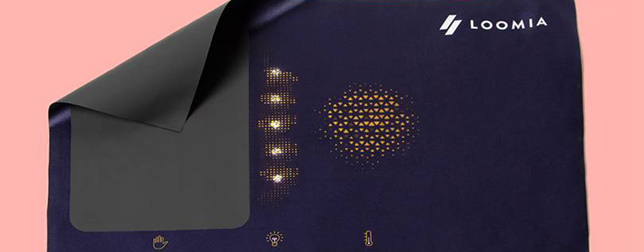LOOMIA, a Brooklyn, NY-based smart-textile startup has developed a material that, when connected to sensors, can heat up and emit light.
Loomia envisions that your stylish ankle boots will automatically detect when it’s cold out and heat up to keep your feet warm. Or maybe your favorite designer jacket will light up at night, ensuring that motorists can see you while you ride your bike.
Read more Smart Clothes Are Available At a Store Near You, Choose the One That Fits You the Best
The material is identical to nylon and can be sewn into clothes as seamlessly as a care tag. So far, it has been used in prototypes for household brands including Calvin Klein and The North Face.
“The electronic layering is essentially a drapable, crease-able, stretchable circuit board,” explains Madison Maxey, the founder and chief technology officer of LOOMIA. Before joining LOOMIA, Maxey worked as a master seamstress at a French tailor. In 2013, at the age of 25, she won a Thiel fellowship to pursue advancements in textiles and fashion, and founded her own studio, The Crated. A year later, software company Autodesk made her the artist in residence. It was during that time that she began to experiment with conductive link.
Using conductive ink, circuits can be connected without the need for wiring. In the past, most ink solutions were rigid, making it hard to attach a circuit directly into clothes, and when attached, it would make the fabric heavy and clunky. Maxey’s metal compound has the consistency of Spandex, which she used as the basis for electronic layering. She added a resistive heater to the circuit and it became a self-heating fabric, connected to a slim, tag-like battery which keeps it charged for two years. In 2016, Maxey rebranded The Crated to LOOMIA and hired long-time friend Janett Liriano as CEO.
The duo soon realized that electronic layering could do more than just react to the environment; it could also be used to gather data.

“There probably isn’t a better way to track your motion than by using your clothes,” says Liriano. But they weren’t interested in making a Fitbit-style wearable, and they were uncomfortable with the security and privacy issues around storing personal.
Read more Conformal 3D-Shaped Coatings Could Be a Game-Changer in Conductive Ink Business
So, they created LOOMIA TILE: a wearable device that can be stitched into the seams of clothing and connected to sensors. It gathers data as someone wears it. “With the tag and its sensors, we know when this jacket is moving, that it’s 20°C, that you’ve worn it seven times this month,” says Liriano.
Fashion companies could be benefited by this type of data by learning how often a person wear and wash products, for example.
When the user wants to share their data, they can scan the TILE with their phone and submit the information to Storj. Brands will then pay users for their data in LOOMIA’s cryptocurrency tokens, created on the Ethereum blockchain. Using these tokens customers can purchase goods through the TILE app.












